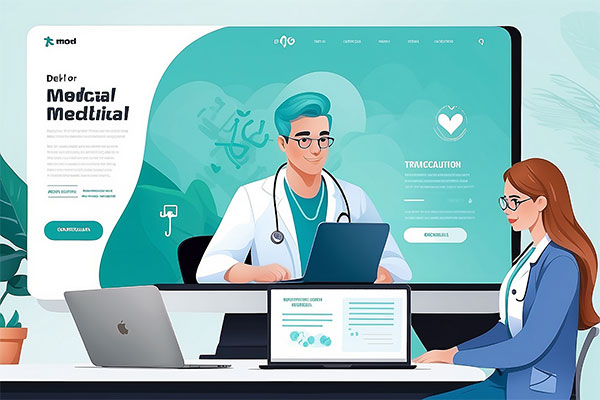
In today’s healthcare landscape, patient engagement is more than just a buzzword—it’s a critical component of successful healthcare delivery. With the rapid adoption of technology, healthcare providers are realizing that digital marketing isn’t just about advertising services; it’s about building relationships, educating patients, and fostering loyalty. In this article, we’ll explore how digital marketing improves patient engagement and retention by leveraging key strategies such as email marketing, personalized content, and interactive websites. Whether you’re a small practice or a large hospital, understanding these digital tools can help transform your patient relationships and drive sustainable growth.
The Digital Revolution in Healthcare
The digital revolution has dramatically reshaped the way healthcare providers interact with patients. Gone are the days when information was solely conveyed through in-person visits or printed brochures. Today, patients expect a seamless digital experience—one that not only informs but also engages them at every step of their healthcare journey.
Why Digital Marketing Matters in Healthcare?

- Enhanced Accessibility: Digital platforms allow patients to access information about healthcare providers, treatment options, and health tips at their convenience. This round-the-clock accessibility builds trust and encourages patients to engage more actively in their care.
- Improved Communication: Digital marketing channels, including social media, email, and interactive websites, provide healthcare providers with the opportunity to communicate with patients in real-time. This open line of communication is crucial for addressing patient concerns, sharing updates, and fostering a sense of community.
Visit: seo strategies for doctors
- Personalized Experience: With the advent of advanced analytics and data-driven strategies, digital marketing now enables providers to tailor content and services to the unique needs of each patient. This level of personalization not only enhances patient satisfaction but also encourages loyalty.
- Cost-Effective Engagement: Compared to traditional advertising, digital marketing is often more cost-effective and measurable. Providers can track the success of their campaigns through metrics like click-through rates, engagement levels, and conversion rates, ensuring that every rupee spent contributes to better patient outcomes.

Email Marketing: The Backbone of Patient Communication
One of the most powerful tools in digital marketing is email. In the healthcare sector, email marketing plays a vital role in nurturing patient relationships, providing ongoing education, and ensuring timely communication.
How Email Marketing Boosts Patient Engagement?
1. Regular Updates and Reminders:
Email marketing allows healthcare providers to keep patients informed about upcoming appointments, new services, and seasonal health tips. Regular communication ensures that patients remain connected to the practice even when they are not physically present.
Example: A monthly newsletter that includes health tips, patient success stories, and practice updates can remind patients of your commitment to their well-being. It can also serve as a gentle reminder for routine check-ups or vaccinations.
2. Personalized Content:
With segmentation and personalization techniques, email campaigns can be tailored to specific patient groups based on their medical history, interests, or previous interactions with your practice. Personalized emails can address individual needs and make patients feel valued.
Interactive Tip: Encourage readers to click on personalized surveys or polls embedded in emails. This not only gathers useful data but also makes the patient feel involved in the care process.
3. Educational Value:
Emails can be used to share educational content that helps patients manage their conditions, understand treatment plans, and make informed health decisions. Content that provides tangible value can build trust and position your practice as an authority in the field.
Example: An email series on “Managing Diabetes Effectively” can include tips, recipes, and links to relevant blog posts or videos. This not only educates patients but also reinforces your expertise.
4. Automation and Follow-Up:
Automation tools allow for the creation of drip campaigns that nurture leads over time. For instance, patients who sign up for a health newsletter can receive a series of follow-up emails with more in-depth content. Automation ensures that the engagement process is continuous and that no patient feels neglected.
Interactive Exercise: Encourage patients to subscribe to your email list by offering a free downloadable guide on “10 Tips for a Healthier Lifestyle.” Use the opportunity to collect feedback on what topics interest them the most.
Elevate your healthcare marketing strategy with our specialized digital marketing company in India for doctors. We craft personalized, data-driven campaigns that not only improve patient engagement but also boost retention. Reach out now and let us help your practice thrive in the digital era!

Personalized Content: Crafting Tailored Patient Experiences
In an era where generic content no longer cuts through the noise, personalized content is key to engaging patients on a deeper level. Personalized digital experiences make patients feel seen and understood, which is critical in building long-term loyalty.
Strategies for Creating Personalized Content
1. Data-Driven Insights:
Use patient data, analytics, and feedback to understand what content resonates with your audience. This can range from frequently asked questions to the most common health concerns in your community.
Example: If your data shows that a significant portion of your audience is interested in preventive care, create blog posts, videos, and infographics focused on that topic.
2. Tailored Messaging:
Craft messages that address specific patient needs. Use segmentation to group patients by age, condition, or even lifestyle. This ensures that each segment receives content relevant to their unique situation.
Interactive Tip: Implement quizzes or interactive surveys on your website that help determine a patient’s interests or health goals. Use the results to recommend personalized content or follow-up emails.
Visit: why local seo for dentists
3. Storytelling:
Patients connect with stories. Share patient success stories (with appropriate consent) that highlight the transformative impact of your care. Real-life narratives can be powerful tools for building trust and encouraging others to engage with your services.
Example: A video testimonial from a patient who successfully underwent a life-changing procedure can be shared across your digital platforms to inspire others.
4. Visual Personalization:
Use personalized visuals, such as interactive infographics or custom animations, to present complex medical information in an engaging and easily digestible format. Visual content is not only more engaging but also aids in better retention of information.
Interactive Exercise: Host a webinar where patients can interact with a live poll or Q&A session. Tailor the discussion based on real-time audience input.

Interactive Websites: The Digital Front Door
Your website is often the first interaction a patient has with your practice. In today’s competitive landscape, an interactive and user-friendly website is crucial for patient engagement and retention.
Key Features of an Interactive Healthcare Website
1. User-Centric Design:
A well-designed website prioritizes the user experience. It should be intuitive, easy to navigate, and accessible to patients of all ages. An effective website design incorporates responsive design, fast loading times, and clear calls-to-action.
Example: Include an easy-to-find “Book Appointment” button on every page. The simpler the process, the more likely patients are to engage.
2. Interactive Tools:
Features like appointment scheduling, live chat support, and symptom checkers can significantly enhance patient engagement. These tools allow patients to interact with your practice in real-time, addressing concerns and providing immediate assistance.
Interactive Tip: Consider integrating a chatbot that answers common patient queries. This can improve the user experience and reduce the load on your administrative staff.
3. Educational Resources:
Your website should be a hub for educational content. Create dedicated sections for blog posts, videos, FAQs, and downloadable resources. This positions your practice as an authority in healthcare and provides value to patients.
Example: A section titled “Health Hub” can offer articles on various health topics, patient guides, and interactive health assessments.
4. Personalization and Dynamic Content:
Implementing dynamic content that adjusts based on user behavior can significantly enhance engagement. For instance, returning visitors might see content related to their previous interactions or interests.
Interactive Exercise: Use website analytics to track user behavior and then implement personalized content recommendations. Ask visitors to complete a brief survey on their interests to further tailor their experience.
Transform your online presence with the best web development company in India. Our team builds interactive, user-friendly websites designed to enhance patient engagement and drive conversions—contact us today to start your journey toward digital excellence!

The Role of Social Media in Patient Engagement
While your website and email marketing strategies are central, social media plays a vital role in how digital marketing improves patient engagement. Platforms like Facebook, Instagram, and LinkedIn provide additional channels for reaching patients, sharing content, and building a community.
Social Media Best Practices for Healthcare Providers
1. Regular, Value-Driven Content:
Post content that is informative, engaging, and visually appealing. Whether it’s a short video on healthy living tips, a patient testimonial, or an infographic on a common health issue, consistent content keeps your audience engaged.
Interactive Tip: Use live sessions or webinars on social media to interact with your audience in real-time. Encourage questions and discussions to build a community.
2. Engagement and Interaction:
Respond promptly to comments, questions, and reviews. Active engagement on social media not only improves your reach but also builds trust. Patients are more likely to choose a provider who is accessible and responsive.
3. Local Targeting:
Utilize geo-targeted ads and local hashtags to reach patients in your service area. This is especially important for practices that rely on local patient populations.
Example: Use targeted ads on Facebook and Instagram to promote special offers, new services, or community events.
Measuring Success: Analytics and Continuous Improvement
To truly understand how digital marketing improves patient engagement, it’s essential to measure the success of your campaigns. Digital marketing offers unparalleled data insights that allow you to track engagement, conversion, and retention rates.
Key Metrics to Monitor
1. Website Analytics:
Traffic: Monitor the number of visitors and their behavior on your website. High traffic with low engagement may indicate usability issues.
Conversion Rates: Track the percentage of visitors who book appointments, subscribe to newsletters, or download resources.
Bounce Rates: A high bounce rate might signal that visitors are not finding what they expected on your website.
2. Email Marketing Metrics:
- Open Rates: Measure how many recipients open your emails. This indicates the effectiveness of your subject lines and the relevance of your content.
- Click-Through Rates (CTR): Track how many readers click on links within your emails, which shows the level of engagement with your content.
- Conversion Rates: Determine how many email recipients take the desired action, such as booking an appointment.
3. Social Media Metrics:
- Engagement Rates: Likes, shares, comments, and saves are all important indicators of how well your content resonates with your audience.
- Follower Growth: Tracking the growth of your social media followers over time helps assess the overall reach of your digital efforts.
- Referral Traffic: Use analytics tools to see how much traffic is directed to your website from social media channels.
Visit: social media to boost medical practices
Continuous Improvement
The digital landscape is constantly evolving, so it’s essential to regularly review your analytics and adjust your strategies. A/B testing different email subject lines, social media post formats, and website layouts can help refine your approach. Listen to patient feedback, monitor emerging trends, and be prepared to pivot your strategy for maximum impact.
Digital marketing is revolutionizing healthcare by transforming how providers interact with and engage patients. Through targeted email marketing, personalized content, and interactive websites, healthcare providers can build stronger, more meaningful relationships with their patients. By focusing on the digital strategies discussed in this article, you can clearly see how digital marketing improves patient engagement—from driving website traffic and enhancing communication to nurturing loyalty and ultimately improving patient retention.
The journey toward a robust digital presence begins with understanding your audience, leveraging advanced analytics, and continuously refining your strategy. With the right mix of educational content, interactive tools, and personalized messaging, you can create a digital ecosystem that not only informs and engages but also builds lasting trust and loyalty among your patients.
As the healthcare industry evolves, staying ahead means embracing digital innovations that empower both providers and patients. The future of healthcare is digital, and with the right strategy in place, you can ensure your practice not only keeps pace but leads the way.
In summary, if you’re looking to revolutionize your patient relationships and drive long-term growth, understanding how digital marketing improves patient engagement is essential. By implementing these strategies, you can foster an environment where patients feel informed, valued, and connected—ensuring that your practice remains the first choice for quality healthcare in an increasingly digital world.
Embrace the digital revolution today. Transform your patient engagement strategy, drive measurable results, and set a new standard in healthcare communication and retention. The tools are at your fingertips—now is the time to invest in your digital future and watch your practice thrive!
Share Your Project Requirements With Us






